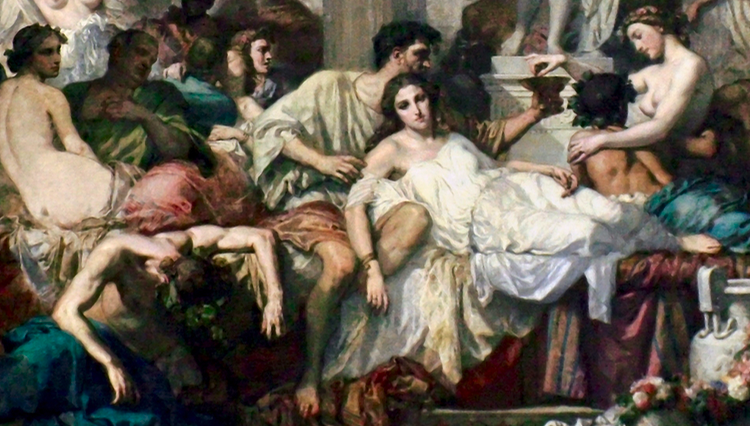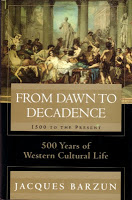In the annals of writing history, there are a handful of volumes that have become established as models due to tone, insightful content, and excellence of style. The most recent historical work by Jacques Barzun is such a work. It is a cultural history of the highest standard. As a historical volume of such scope, From Dawn to Decadence is a tightly-woven, extremely engaging narrative, wealthy with detail and interpretative insights.
From Dawn to Decadence is impressive in both depth and breadth. Barzun establishes several themes that he traces throughout the book. The work is separated into four epoch eras, each spanning approximately 125 years. Among the themes explored within the book are some which reflect the ideas and habits that have at times integrated, at other times divided but throughout shaped western cultural life, Barzun insightfully identifies abstraction, analysis, emancipation, individualism, primitivism, secularism, self-consciousness, specialism, and scientism. However, this approach is not taken within an abstract arena. “History is above all concrete and particular, not general and abstract” (xvi). This erudite author demonstrates this truth with several “cross sections” that function as windows into a particular moment and place in time. Barzun also provides numerous quotes within the margins from primary sources which enhance each chapter.
The table of contents is below:
Part I From Luther’s Ninety-five Theses to Boyle’s “Invisible College”
Part II From the Bog and Sand of Versailles to the Tennis Court
Part III From Faust, Part I, to the “Nude Descending a Staircase No. 2”
Part IV From “The Great Illusion” to “Western Civ Has Got to Go”
The past twenty years has seen an advent of the ”new history” which frequently fails the test of being good history. Barzun is a practitioner of the traditional form of cultural history. According to Barzun, “culture is a web of many strands; none is spun by itself,” (ix). It is because of the intricately connected nature of culture that the author will often relate the ideas to specific institutions, events, or even manners.
While Barzun does acknowledge some of the everyday artifacts that have shaped western cultural life, he gives greater attention to the great revolutions that impacted the western way of life because these revolutions “give culture a new face” (3). Employing extraordinarily clear and concise prose, Barzun traces the birth, development and continued effect of these revolutions.
In light of the recent trends to model a corruption of history with the all too trendy anti-western bias, the tone of Barzun’s work is refreshingly and typically conservative. However, this does not limit him from an occasional challenge of received “wisdom” especially related to the late middle ages and early Renaissance.
There are many special insights the reader is exposed to throughout this work. Barzun skillfully traces the thread that runs from Luther’s 95 theses to America’s “Me Decade” of the 1970s. He also keenly observes that the foundation of the current consumer culture has its roots in the scientific and industrial revolution.
Barzun is most often gracious even when reflecting on differing convictions and results. While discussing the Eutopias, he contends that the basic flaw is “taking it for granted that under fair conditions people would be sensible” (126). On the other hand he praises them “in letting wish and fancy roam, this galaxy of writers have imagined institutions that are workable” (126).
From Dawn to Decadence is filled with key figures, major social and cultural movements, great books and ideas with momentous consequences. Barzun demonstrates his immense scholarship as he relates religious, political, artistic, general cultural, and social revolutions to the shape of western civilization. This impressive book being both encyclopedic and anecdotal introduces the reader to significant men (and yes, many women) who for good and ill influenced their age.
Barzun may give more credit than is appropriate to certain cultural figures such as Sigmund Freud. Even Barzun observes, “note that although the world understands what Freud meant by the Oedipus complex, nobody has the slightest notion of how Oedipus felt when he killed his father and married his mother” (141).
Barzun offers a powerful and prophet-like critique of the past with prospects of the future. In particular, the last chapter, “Demotic Life and Times,” describes a culture tragically drifting into the abyss. “In attempting a sketch of a culture at its close, the elements to look for may be classed under the headings of style and society, style meaning the choices made by individuals, and society meaning the ways of institutions” (773).
Among the many markers of the demotic in our current moment, the clearest sign of the demotic style is related to clothing. “The Unfitting appealed to the young but was not their monopoly. A sample of the casual style among adults had been to sport a business suit at the opera; this expanded into the open collar and no tie or jerseys and T-shirts almost anywhere, even in church” (782). The slide from the internal, introspective, character moves to the momentarily temporal and the easily changed external.
Barzun accurately describes the demotic society as a society overseen by bureaucrats, inhabited by consumers who are shaped by a dominate therapeutic consciousness. This society is amused by journalism qua entertainment and en masse has shifted from the concrete to the virtual via the Internet.
In addition to the sign of clothing as a marker of the demotic spirit is the obviously diminished language. “The demotic languages were decadent because verbal inflation and misusage interfered with vigor, precision, and clarity. Correctness had ceased to be recognized; it was, on the contrary, denounced” (792, 793).
However, all is not lost. Barzun concludes on a more futuristically projected hopeful note by imagining, “What saved the masses from brutishness was the survival (though in odd shapes) of a good deal of literature and history from 500 years of western culture, mingled with a sizeable infusion of the eastern” (800).
Indeed some may find fault with the balance of the book giving greater attention to the first 300 years and less toward the last 200, it may simply be due to the fact that the decadent end of a civilization is more burdensome to chronicle than the glorious dawn of that civilization.
Barzun generally treats religion respectfully, his own convictions are apparent when it comes to the place divine providence may have in the unfolding of human cultural history. “Acting together with character, circumstance accounts for the chaos of history, and its unpredictable twists and turns, which cannot always be referred to motives” (136).
While being impressive in scope, over 800 pages of text, this history book may indeed be a tad overwhelming for some readers. The explanation for the size and scope of the work may be found within the book itself. Barzun provides a simple definition of the Renaissance man in the fullest sense of that term, as one who is “concerned with everything in the universe” (141). Using his own definition, Barzun is a true Renaissance man who has given us a masterpiece of cultural history for renewed reflection.
This essay was first published here in August 2011.
The Imaginative Conservative applies the principle of appreciation to the discussion of culture and politics—we approach dialogue with magnanimity rather than with mere civility. Will you help us remain a refreshing oasis in the increasingly contentious arena of modern discourse? Please consider donating now.
The featured image (detail) is “Les Romains de la décadence” (1847), a painting by Thomas Couture in the Musée d’Orsay, Paris. This file is licensed under the Creative Commons Attribution-Share Alike 4.0 International, 3.0 Unported, 2.5 Generic, 2.0 Generic and 1.0 Generic license. It appears here courtesy of Wikimedia Commons.



